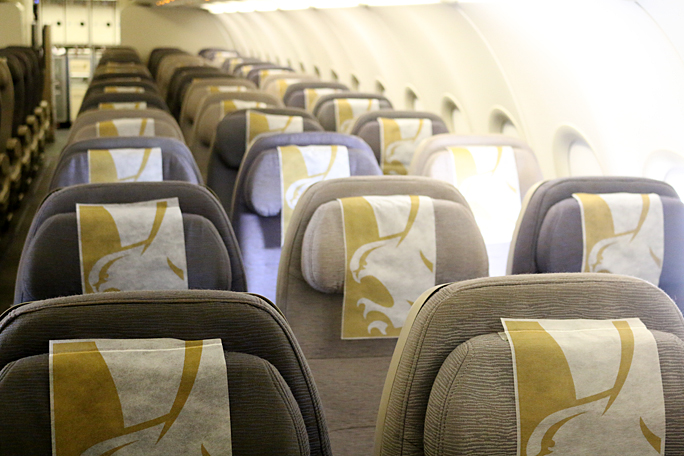“T he average distance between rows of seats has dropped from 35 inches before airline deregulation in the 1970s to about 31 inches today. The average width of an airline seat has also shrunk from 18 inches to about 16 ½.”
That is the rationale behind the Seat Egress in Air Travel — or SEAT — Act which was introduced to direct the Federal Aviation Administration of the United States to establish minimum seat size standards for the safety and health of airline passengers.
Amendments to Establish Minimum Seat Size Standards Aboard Airplanes
“Consumers are tired of being squeezed both physically and fiscally by airlines,” Steve Cohen — who is a member of Congress representing the ninth district in Tennessee and a member of the Subcommittee on Aviation of the House Transportation and Infrastructure Committee; and is no relation to me, as far as I know — said in this statement which was posted on his official Internet web site. “Shrinking seat sizes isn’t just a matter of comfort but safety and health as well. The Federal Aviation Administration requires that planes be capable of rapid evacuation in case of emergency, yet they haven’t conducted emergency evacuation tests on all of today’s smaller seats. Doctors have also warned that deep vein thrombosis can afflict passengers who can’t move their legs during longer flights.”
Those who are knowledgeable pertaining to reduced seat pitches and legroom between seats aboard commercial airplanes are concerned that the ability to evacuate in the event of an emergency could hinder the egress of passengers.
“The lack of legroom on some planes is not only uncomfortable, we are not even sure if it is safe,” Janice Hahn — who is a member of Congress representing the 44th district in California and is also a member of the Subcommittee on Aviation of the House Transportation and Infrastructure Committee — said in this statement which was posted on her official Internet web site. “The safety of passengers cannot be sacrificed for a higher bottom line. Frankly, cutting costs by shrinking seat sizes at a time when fuel prices are low, and airline profits are soaring, is just greedy at the expense of the passengers’ comfort and safety.”
Seat Egress in Air Travel Act Defeated
The amendment to House of Representatives bill 4441 — also known as the Aviation Innovation, Reform, and Reauthorization Act of 2016 — which Steve Cohen co-authored with Janice Hahn was defeated by fellow members of the House Transportation and Infrastructure Committee yesterday with 26 votes in support of the amendment and 33 votes opposed…
…along with a second amendment from the duo which would require the Federal Aviation Administration to test the safety of smaller seats which are increasingly common aboard commercial airplanes.
Reaction
“Refusing to even mandate that the FAA study personal space on aircraft and evacuation of aircraft with the newly packed-in seating, and including an amendment that legalizes misleading and deceptive advertising, is simply irresponsible”, said Charlie Leocha, who is the chairman of Travelers United, which is a nonprofit, nonpartisan membership consumer advocacy organization that works to provide consumers an articulate and reasoned voice in decisions that affect consumers across the entire spectrum of travel. “Today’s FAA bill markup was a sad example of a sad committee ruining what could have been good, courageous legislation.”
I have not received word yet at this time from any representatives of Airlines for America — which is a trade group for the commercial aviation industry in the United States — pertaining to reaction of the defeat of both amendments.
Summary
I completely agree with Charlie Leocha on this issue. There comes a point where basic comfort and safety for passengers cannot be compromised anymore at the expense of corporate profits. I do not personally know if the airlines have reached or breached that point with regard to minimum recommendations; but there is only so much space aboard an airplane — and to keep thinning down seats and squeezing more of them in the same space is akin to watering down soup or a beverage: eventually, the experience is compromised to the point where the consumer no longer can enjoy it and will not be willing to pay the price for it.
We seem to be in a society where if something is wrong or not working, the solution is to overcorrect it. Yes, there were the days when airlines were hemorrhaging billions of dollars per year while giving passengers more room throughout coach — remember that? — and having them enjoy amenities which airlines simply could not sustain. Yet — at that time — that was all airlines knew in terms of how to retain customers. If they were not desperate, they sure seemed to be close to that point…
…but today — despite raking in record profits quarter after quarter — airlines are still attempting to squeeze every last penny out of their passengers, who have to endure sitting closer to each other in tighter spaces in seats with little padding.
Normally, I eschew government regulation to force an issue which should be impacted by supply and demand of the market — but with the tightened oligopoly of the commercial aviation industry in the United States, passengers do not have many choices — especially with the hub-and-spoke system of flights by most airlines. Upgrades to the premium class cabin may be fewer and amenities may be becoming more scant; but passengers have a right to minimum standards for basic comfort and safety when traveling by any conveyance regulated by the government — whether it be airplane, bus, train or boat — regardless of what they pay for a ticket…
…lest we see the day where airlines decide to eliminate seats and have a standing room only section for passengers…
Photograph ©2015 by Brian Cohen.
